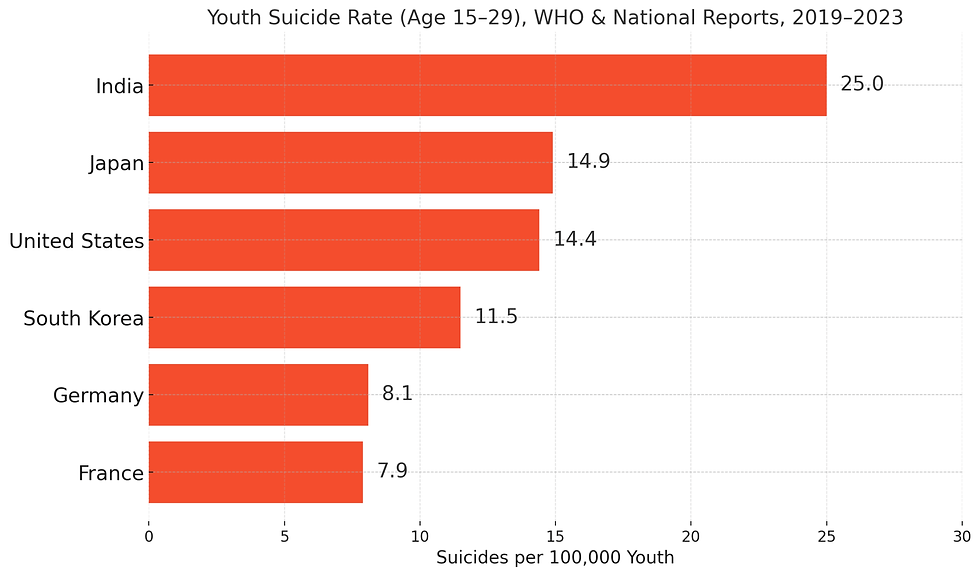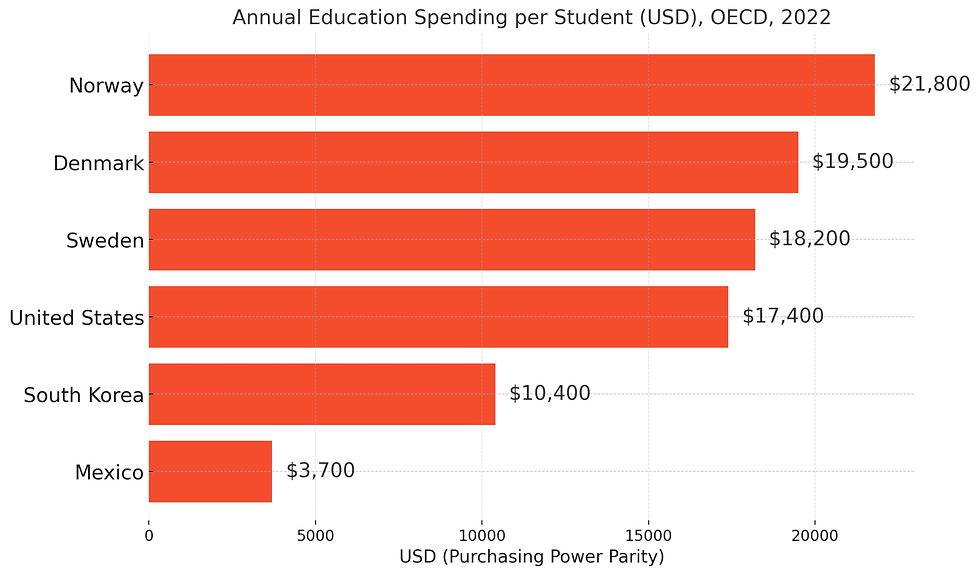Is more school or more exams better?
- snitzoid
- 5 hours ago
- 4 min read
Honestly, in my case being incredibly gifted really made school a fricken joke. I guess other kids were pulling their hair out and developing ulcers.
But, as JFK famously said, "better to give an ulcer than to get one".
World Population Review
Sept 12, 2025
1. 🇰🇷 South Korea: Where Exams Decide Everything
In South Korea, the college entrance exam isn’t just a test—it’s a national event. Known as the Suneung, this grueling 8-hour marathon effectively determines a student’s future, from university placement to marriage prospects. Flights are grounded during listening sections, and the stock market opens late.
Why the intensity? Korea’s Confucian roots, combined with a fiercely competitive economy, have built an education culture that equates academic success with survival. Students often endure 12+ hour study days in private after-school academies, called hagwons, chasing marginal gains in test performance.
Yet cracks are showing. Youth mental health has become a crisis, with South Korea having one of the highest teen suicide rates in the OECD. Parents and policymakers are now rethinking the cost of high performance.
🔍 Did you know? Some Seoul districts ban hagwons from operating past 10 PM—but enforcement is lax, and many push well beyond midnight.

2. 🇫🇮 Finland: The Anti-Exam Model That Works
Finland has become education’s quiet revolution. There are virtually no standardized tests until the final year of high school—and yet Finnish students routinely outperform peers in global benchmarks like the PISA assessments.
How? The Finnish system emphasizes teacher autonomy, equal opportunity, and play-based learning in early years. Teachers are highly trained (master’s degree required) and deeply respected. Students rarely get homework in elementary school, and private tutoring is nearly nonexistent.
The result? Low stress, high equity, and strong outcomes in literacy, math, and science. Finland proves you don’t need high-stakes testing to achieve excellence.
🔍 Unexpected truth: Despite minimal testing, Finland has one of the highest teacher satisfaction rates in the world.

3. 🇺🇸 United States: Testing for Accountability or Anxiety?
America’s test culture is a paradox. While not as intense as Asia, it’s deeply embedded in policy. From No Child Left Behind to the SAT, standardized testing is used to assess school quality, track student progress, and influence college admissions.
But the backlash is growing. Critics argue these tests disadvantage low-income and minority students, foster teaching to the test, and fail to measure creativity or critical thinking. In 2024, more than 80% of U.S. colleges made SAT/ACT scores optional or eliminated them entirely.
However, gaps remain. Many states still mandate annual testing in grades 3–8. The debate now is whether testing drives improvement—or just stress.
🔍 By the numbers: U.S. students take an average of 112 standardized tests between pre-K and high school graduation.

4. 🇨🇳 China: Gaokao—A Gatekeeper and a Pressure Cooker
China’s Gaokao is often described as the most competitive exam in the world. Taken by over 12 million students annually, this two-day test decides university admission, career prospects, and, for many rural families, the hope of upward mobility.
The stakes are so high that students live on military-style schedules, and entire villages mobilize to support test-takers. A single point can mean the difference between a top university or a dead-end path.
But reforms are slowly emerging. Pilot provinces now offer multiple test attempts, diversified scoring, and more holistic evaluations. The challenge? Balancing tradition with innovation in a system where testing is deeply tied to fairness and meritocracy.
🔍 Little-known fact: In some Chinese schools, “Gaokao rooms” are built with padded walls to minimize distraction and anxiety.

5. 🇮🇳 India: A Nation of Exams and Inequality
India’s exam system is vast—and often brutal. From the Class 10/12 board exams to high-stakes entrance tests like JEE and NEET, millions of students compete annually for limited seats at top institutions.
Success can transform lives; failure often leads to despair. Suicide rates among Indian students have spiked in recent years, with pressure, parental expectations, and societal stigma playing major roles.
Meanwhile, inequality runs deep. Wealthy families pay for elite coaching centers, while rural students face inadequate resources. Reforms have begun—like reducing syllabus loads and offering more flexible assessments—but systemic change is slow.
🔍 Grim statistic: India reported over 13,000 student suicides in 2021—that’s one every 40 minutes.

6. 🇸🇪🇳🇴🇩🇰 The Nordic Middle Ground: Balanced, Not Burned Out
While Finland gets most of the glory, its Nordic neighbors—Sweden, Norway, and Denmark—have also carved out balanced models of education where fewer tests meet strong outcomes.
Sweden and Norway emphasize formative assessment, giving students feedback instead of grades in early years. Denmark recently abolished national tests for young children, citing concerns about stress and equity.
These countries also blend education with broader social safety nets—free meals, counseling, and universal childcare—supporting the whole child, not just academic performance.
🔍 Policy twist: Norway provides every high school student with a free laptop, recognizing that digital equity is essential for educational success.

7. 🇯🇵 Japan: Quiet Pressure, Gradual Change
Japan’s reputation for educational discipline is well-earned. From entrance exams to after-school juku (cram schools), the culture demands excellence—and conformity.
But unlike South Korea or China, Japan’s pressure is more subtle, even polite. Students prepare intensely but also participate in school cleaning, moral education, and collaborative learning. The exam system is rigorous, but not totalizing.
Still, there are worries about burnout, declining youth happiness, and the country’s shrinking school-age population. Reforms are underway, including more diverse university admissions and greater focus on creativity.
🔍 Curious insight: Some top Japanese universities now accept international students based on essay interviews and GPA, bypassing traditional exams entirely.

Exams shape more than grades—they shape lives. They can open doors or slam them shut. Signal progress or expose pressure points.
As nations rethink the cost of constant testing, one thing is clear: how we assess learning reveals what we truly value.
So whether you're raising a child, planning a move, or simply staying globally aware—watch the tests. They're telling a deeper story.
Comments